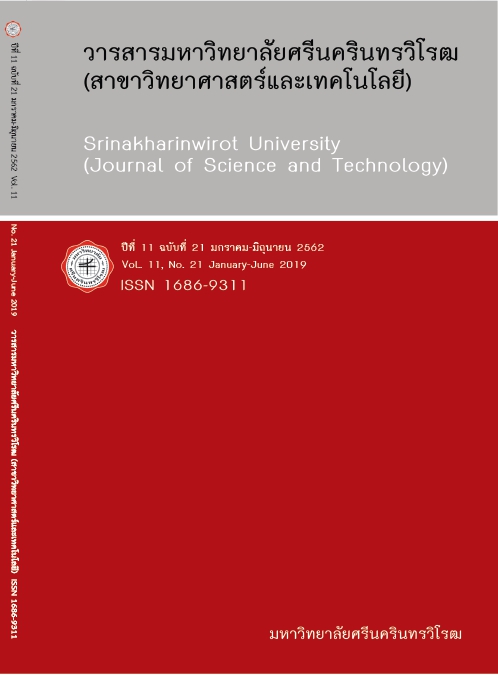การพัฒนาผลิตภัณฑ์พุดดิ้งผักเพื่อผู้สูงอายุและผลของการเก็บรักษาผลิตภัณฑ์ต่อปริมาณ โพลีฟีนอลทั้งหมดและฤทธิ์การต้านอนุมูลอิสระ FORMULATION OF VEGETABLE PUDDING FOR ELDERLY AND THEIR STORAGE EFFECT ON TOTAL PHENOLICS AND ANTIOXIDANT ACTIVITIES
Keywords:
Storage, Antioxidant Activities, Total Phenolic Contents, Vegetable PuddingAbstract
Pudding is a nutrient-rich dessert commonly served for elderly who is lack of chewing ability due to tooth loss because of its soft texture. Pudding is usually composed of milk, oil, sugar and hydrocolloids. The aim of this study was to formulate ready-to-eat pudding containing essential nutrients with varying types of vegetable powder added, including sweet potato (SP), sweet corn (SC), and pumpkin (PK) powder. The pudding was studied the sensory acceptability, color, total phenolic contents (TPC) and antioxidant activities (AA) measured by 2,2-diphenyl-1-picrylhydrazyl (DPPH) and oxygen radical absorbance capacity (ORAC) assays. The effect of storage time on the color, TPC and AA of each developed formula was also investigated. The vegetable powder was added at 8% (w/w) separately into the control. All developed puddings were accepted by the panelists at like moderately of overall acceptability. Although, the color of vegetable puddings were darker than the control, the panelists still accepted. The TPC and AA of vegetable puddings were greater than that of the control, particularly SC and PK pudding. The TPC content of SP pudding was similar to that of the control, whilst the AA of it was higher than that of the control. The developed products stored at 35 ºC for 12 weeks showed that the color was darker. TPC of all formulas were highest at week 6, and then declined until week 12. The AA of the vegetable pudding increase somewhere during storage time, then reduced at the week 12. This study demonstrated that vegetable powder affected TPC and AA. Furthermore, the storage time played an important role on TPC and AA. These products are prototype of supplement for elderly which have health benefits beyond basic nutrition. In addition, these products can be extended to children and health conscious consumers as well.
Downloads
References
[2] Bureau of Dental Health. (2012). The oral health of Thais in 2012. Bangkok: Bureau of Dental Health, Department of Health.
[3] Sahyoun, N.R., Z.X.; and Serdula, M.K. (2005). Barriers to the consumption of fruits and vegetables among older adults. Journal of nutrition for the elderly. 24(4): 5-21.
[4] Brennan, D.S., Singh, K.A., Liu, P.; and Spencer, A.J. (2010). Fruit and vegetable consumption among older adults by tooth loss and socio-economic status. Australian Dental Journal. 55: 143-149.
[5] Inomata, C.I.K., Okada, T., Takeshita, H.; and Maeda, Y. (2015). Impact on Dietary Intake of Removable Partial Dentures Replacing a Small Number of Teeth. The International Journal of prosthodontics. 28(6): 583-585.
[6] Wakai, K., N.M., Naito, T., Kojima, M., Nakagaki, H., Umemura, O., Yokota, M., Hanada, N.; and Kawamusra, T. (2010). Tooth loss and intakes of nutrients and foods: a nationwide survey of Japanese dentists. Community Dentistry Oral Epidemiol. 38(1): 43-49.
[7] Ares, G., Baixauli, R., Sanz, T., Varela, P.; and Salvador, A. (2009). New functional fibre in milk puddings: Effect on sensory properties and consumers' acceptability. LWT Food Science and Technology. 42: 710-716.
[8] Elmore, J.R., Heymann, H., Johnson, J.; and Hewett, J.E. (1999). Preference mapping: relating acceptance of ‘creaminess’ to a descriptive sensory map of a semi-solid. Food Quality and Preference. 10: 465-475.
[9] Brewer, M.S. (2011). Natural antioxidants: Sources, compounds, mechanisms of action, and potential applications. Comprehensive Reviews in Food Science and Food safety. 10: 221-247.
[10] Cserhalmi, Zs., Sass-Kiss, A., Toth-Markus, M.; and Lechner, N. (2006). Study of pulsed electric field treated citrus juices. Innovative Food Science and Emerging Technologies. 7: 49-54.
[11] Charoenkiatkul, S., Judprasong, K.; and Thiyajai, P. (2016). Nutrients and bioactive compounds in popular and indigenous durian. Food Chemistry. 193: 181-186.
[12] Ainsworth, E.A.; and Gillespie, K.M. (2007). Estimation of total phenolic content and other oxidation substrates in plant tissues using Folin-Ciocalteu reagent. Nature Procols. 2: 875-877.
[13] Fukumoto, L.R.; and Mazza, G. (2000). Assessing antioxidant and prooxidant activities of phenolic compounds. J.agric.Food Chem. 48: 3597-3604.
[14] Ou, B., Hampsch–Woodil, M.; and Prior, R.L. (2001). Development and validation of an improved oxygen radical absorbance capacity assay using fluorescein as the fluorescent probe. Journal of Agricultural and Food Chemistry. 49: 4619-4626.
[15] Chen, BH.; and Huang, JH. (1998). Degradation and isomerization of chlorophyll a and β-carotene as affected by various heating and illumination treatments. Food Chem. 62(3): 299-307.
[16] Yuanxia, S., Shigeru, H., Masahiro, O.; and Ken, I. (2007). Antioxidant properties of custard pudding dessert containing rare hexose, D-psicose. Food Control. 18: 220–227.
[17] Rufián-Henares, J.; and Morales, F.J. (2007). Functional properties of melanoidins: in vitro antioxidant, antimicrobial and antihypertensive activities. International Food Research Journal. 40(8): 995-1002.
[18] Vinson, J.A., Su, X., Zubik, L.; and Bose, P. (2001). Phenol antioxidant quantity and quality in foods: fruits. Journal of Agricultural and Food Chemistry. 49: 5315-21.
[19] Mgaya-Kilima, B., Remberg, S.F., Chove, B.E.; and Wicklund, T. (2014). Influence of storage temperature and time on the physicochemical and bioactive properties of roselle-fruit juice blends in plastic bottle. Food Science Nutrition. 2(2): 181-191.
[20] Liu, L.X., Sun, Y., Laura, T., Liang, X.F., Ye, H.; and Zeng, X.X. (2009). Determination of polyphenolic content and antioxidant activity of kudingcha made from Ilex kudingcha C.J. Tseng. Food Chem. 112: 35-41.
[21] Prior, R.L., Wu, X.; and Schaich, K. (2005). Standardized methods for the determination of antioxidant capacity and phenolics in foods and dietary supplement. Journal of Agricultural and Food Chemistry. 53: 4290-4302.
Downloads
Published
How to Cite
Issue
Section
License
Srinakharinwirot University Journal of Sciences and Technology is licensed Under a Creative Commons Attribution-NonCommercial-NoDerivs 4.0 International (CC-BY-NC-ND 4.0) License, Unless Otherwise Stated. Please Read Journal Policies Page for More Information on Open Access, Copyright and Permissions.



